The Glucose Sensor Market is estimated to be valued at USD 9.7 billion in 2025 and is projected to reach USD 22.2 billion by 2035, registering a compound annual growth rate (CAGR) of 8.5% over the forecast period.
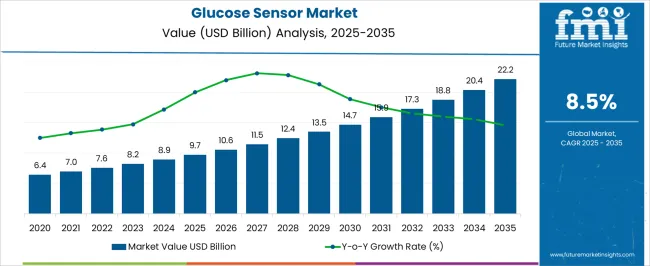
| Metric | Value |
|---|---|
| Glucose Sensor Market Estimated Value in (2025 E) | USD 9.7 billion |
| Glucose Sensor Market Forecast Value in (2035 F) | USD 22.2 billion |
| Forecast CAGR (2025 to 2035) | 8.5% |
The glucose sensor market is expanding steadily, propelled by the rising global prevalence of diabetes, increasing awareness about continuous glucose monitoring, and advancements in sensor technologies. Clinical studies and healthcare reports have emphasized the importance of real-time glucose monitoring in improving patient outcomes, leading to growing adoption in both hospital and outpatient care settings.
Technological innovations, including the use of optical methods, microfluidic systems, and minimally invasive designs, have enhanced the accuracy and patient comfort of glucose sensors. Additionally, government health initiatives and reimbursement frameworks supporting diabetes management tools have further accelerated adoption.
Press releases and investor updates from medtech companies have also highlighted ongoing research collaborations aimed at developing non-invasive and wearable glucose sensors, reflecting a shift towards patient-friendly solutions. Looking ahead, the market is expected to witness continued growth, supported by digital health integration, the use of AI-driven data analytics for glucose pattern recognition, and the expansion of connected care platforms. Hospitals and healthcare institutions are projected to remain key end users, while non-invasive and optical-based technologies lead innovation and adoption.
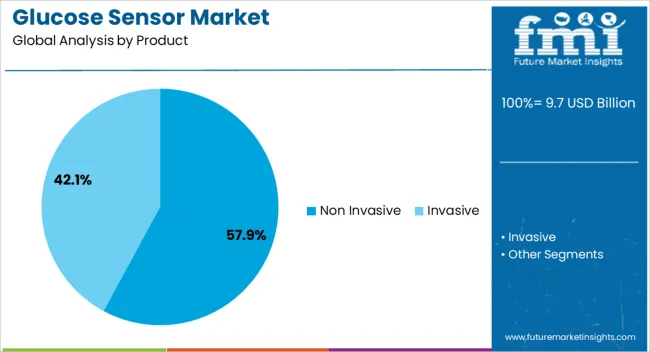
The Non Invasive segment is projected to hold 57.9% of the glucose sensor market revenue in 2025, establishing itself as the leading product category. Growth in this segment has been supported by the increasing demand for pain-free, convenient monitoring methods that improve patient compliance. Non-invasive sensors eliminate the need for finger pricks or implantable devices, offering greater comfort and reducing the risk of infection.
Clinical trials and product announcements have highlighted advancements in wearable devices and optical sensing methods that provide accurate readings without blood samples. Healthcare providers have increasingly recommended these devices for their ability to support continuous monitoring and early detection of glucose fluctuations.
As consumer health technology adoption rises, non-invasive glucose sensors have also gained popularity in homecare and remote monitoring. This alignment of patient preference, clinical need, and technological innovation has solidified the segment’s leading market share.
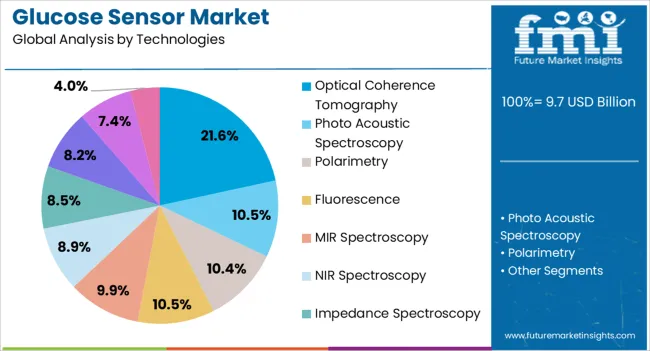
The Optical Coherence Tomography (OCT) segment is projected to account for 21.6% of the glucose sensor market revenue in 2025, positioning itself as a leading technology. The adoption of OCT in glucose monitoring has been driven by its ability to provide high-resolution, non-contact imaging of tissue to measure glucose concentration accurately.
Research articles and technology demonstrations have shown that OCT-based systems offer precision in detecting glucose-induced changes in tissue scattering properties, making them highly reliable. This technology has been favored in both clinical and experimental settings due to its non-invasive nature and ability to generate real-time results.
Investments by medical device companies in OCT-based glucose sensors have been noted in investor presentations, underscoring the growing confidence in its scalability. As patient demand for reliable, non-invasive glucose monitoring grows, OCT technologies are expected to gain further traction, supported by ongoing miniaturization and integration with wearable platforms.
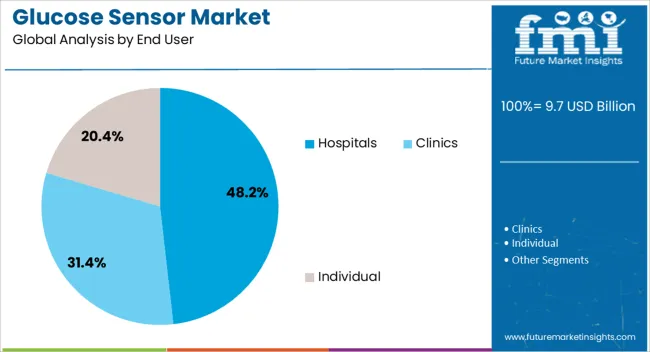
The Hospitals segment is projected to contribute 48.2% of the glucose sensor market revenue in 2025, maintaining its position as the dominant end user. This leadership has been influenced by the reliance of hospitals on advanced glucose monitoring technologies to manage critically ill and diabetic patients.
Hospital-based adoption has been supported by the need for continuous, accurate, and real-time glucose data in intensive care and surgical settings. Clinical guidelines and institutional protocols have emphasized the role of glucose sensors in improving patient safety and reducing complications associated with hyperglycemia and hypoglycemia.
Furthermore, hospitals have benefited from reimbursement support and procurement initiatives that prioritize advanced monitoring systems. Training programs and clinical validation studies conducted in hospitals have also accelerated adoption, ensuring that staff are proficient in utilizing new sensor technologies. With the rising burden of diabetes-related hospitalizations and the increasing integration of connected monitoring systems, hospitals are expected to retain their leadership as the primary end users of glucose sensors.
Non-invasive glucose sensing is a game-changer in diabetic care. Technologies like optical sensors and saliva-based monitors offer pain-free substitutions to traditional methods. They appeal to those hesitant about invasive devices due to discomfort. As these technologies get better, they could transform glucose monitoring industry and enhance life for people with diabetes.
Like, the Know Labs’ new wearable non-invasive continuous glucose monitor launched in February 2025. It is yet to undergo FDA trials but has potential in enhancing the user experience. It has a rechargeable battery and a companion mobile app.
Glucose sensors paired with AI and predictive analytics offer proactive diabetes management. These systems analyze glucose patterns to forecast future levels, foreseeing potential highs or lows.
By giving early alerts and personalized advice, AI-driven monitoring helps individuals with diabetes prevent issues and keep their blood sugar in check. As AI algorithms learn and adapt, they become better at predicting glucose levels, leading to healthier outcomes and lower healthcare costs due to fewer complications. As technology progress, the industry benefits with improved potentials.
| Segment | Invasive (Product) |
|---|---|
| Value Share (2025) | 68.4% |
The invasive product segment holds the leading glucose sensor market shares in 2025. Invasive glucose sensors, like those in CGM systems, offer reliability and accuracy in glucose measurement, owing to proven enzymatic or electrochemical sensing technologies. They provide real-time continuous monitoring, helping in gaining insights into glucose trends and patterns.
They also aid in reducing the risks of hypo- and hyperglycemia by allowing adjustments in insulin dosing. Integration with insulin pumps creates automated systems, that mimic a healthy pancreas. They are affordable and accessible, which makes them more preferred in the industry.
| Segment | Hospitals (End User) |
|---|---|
| Value Share (2025) | 41.4% |
The hospitals end-user segment captured the leading glucose sensor market shares in 2025. With the global rise in diabetes cases, there is a nearly equivalent surge in diabetes-related hospitalizations. Glucose sensors, particularly CGM systems, are important in managing these conditions by offering real-time data for timely interventions.
They are increasingly integrated into hospital workflows, aiding continuous monitoring and improving care coordination. In hospitals, they enhance patient safety by providing early alerts for glucose fluctuations. They help in optimizing insulin therapy and supporting critical care patients in ICUs.
Hospitals are investing in advanced monitoring technologies like these sensors to improve patient outcomes, hastening the demand for these devices in the healthcare sector.
This section analyzes the demand for glucose sensors in key countries as given in the table below. The industry is led by sales of glucose sensors in India. The United States and China are close behind. This indicates that Asia Pacific is emerging as a key hotspot for growth. The demand in Germany is comparatively lower. Australia & New Zealand are showing prospects of promising growth in the coming years. A detailed explanation is below the table.
| Countries | Value CAGR (2025 to 2035) |
|---|---|
| United States | 7% |
| Germany | 5.6% |
| China | 7.5% |
| India | 8.4% |
| Australia & New Zealand | 6.6% |
The demand for glucose sensor devices in the United States will rise at a 7% CAGR till 2035. The American healthcare sector is focusing more on helping patients get better while keeping costs down. Glucose sensors are a big part of this because they help manage diabetes better and prevent problems.
The government and insurance companies decide which sensors are allowed and paid for. People want glucose sensing devices that are easy to use and help them take charge of their health. With millions of diabetic patients in the nation, these sensors are necessary in the healthcare industry.
Dexcom Inc. and Abbott Laboratories are prominent in the United States. These companies offer various diabetic care products. They invest in marketing and promotion to raise awareness of their products. They value product affordability and accessibility.
The glucose sensor sales in Germany will amplify at a 5.6% CAGR until 2035. Preventive healthcare and lifestyle management, specifically for chronic conditions like diabetes, are highly valued. Glucose sensing gadgets that offer proactive monitoring and insights into lifestyle factors are in high demand in Germany.
The country's focus on personalized medicine drives demand for sensors providing tailored recommendations based on individual data. Germany's emphasis on data privacy ensures compliance with strict laws like GDPR, leading to demand for sensors that prioritize patient privacy and security. These factors accentuate the importance of glucose sensing devices in Germany's advanced healthcare system.
Medtronic PLC is popular in Germany. The company has a strong reputation and distribution network in the country, and throughout Europe.
The growth of the glucose sensor market in China is estimated at a 7.5% Y.o.Y. rate until 2035. In China, the government is working on making healthcare better and encouraging new medical technology. Glucose sensor companies can benefit from this support. More people in China are using telemedicine and remote monitoring, especially in places far from hospitals. This helps manage diabetes from afar.
As China's economy grows, people can spend more on healthcare, so there's a bigger need for advanced devices like glucose sensors. More people are moving to cities and changing their lifestyles, which leads to more diabetes.
People in China want glucose monitoring devices that fit their city life. This means there are good opportunities for glucose sensor companies in China.
The demand for glucose sensor devices in India will rise at an 8.4% CAGR until 2035. There is a strong push for healthcare services and technologies to be affordable in the country. Businesses are working on making low-cost options and spreading awareness about them, especially in rural areas.
Since India has diverse cultures, companies are making sure their sensors fit people's preferences and needs, offering language support and personalized help. This reflects a growing opportunity for glucose sensor manufacturers to make a positive impact on India's healthcare landscape.
The demand for glucose sensors in Australia & New Zealand will surge at a 6.6% CAGR till 2035. There is a higher focus on indigenous health in these countries. Glucose sensor manufacturers are working with indigenous communities to create diabetes management solutions tailored to their needs.
Government funding supports healthcare, including subsidies for medical devices like sensors, presenting opportunities for manufacturers. Patient education is also important, with companies investing in programs to help people manage their diabetes better. Collaboration with governments and healthcare groups is key to accessing support and expanding reach in these countries.
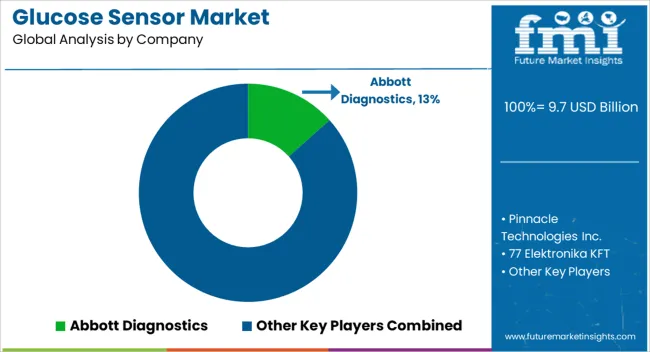
The glucose sensor industry is highly competitive, with players like Abbott Laboratories, Dexcom, and Medtronic leading. These firms prioritize R&D to develop and introduce new technology. Startups also add to the competition with niche solutions, challenging established players. Strategic partnerships and collaborations drive innovation, while regulatory compliance governs market entrance.
Recent Developments
The sector fragments into Non-invasive (Optical Sensors, Trans Dermal Sensors, Minimally Invasive, and Micro pore/ Micro Needles), Invasive (Intravenous Implantable, Micro Dialysis, and Subcutaneous Sensor)
The industry is segmented into Photo Acoustic Spectroscopy, Optical Coherence Tomography, Polarimetry, Fluorescence, MIR Spectroscopy, NIR Spectroscopy, Impedance Spectroscopy, Skin Suction Blister Technique, Sonophoresis, and Reverse Iontophoresis.
The industry bifurcates into Hospitals and Clinics.
Analysis of the market has been conducted in the countries of North America, Latin America, Europe, East Asia, South Asia & Pacific, Middle East & Africa (MEA).
The global glucose sensor market is estimated to be valued at USD 9.7 billion in 2025.
The market size for the glucose sensor market is projected to reach USD 22.2 billion by 2035.
The glucose sensor market is expected to grow at a 8.5% CAGR between 2025 and 2035.
The key product types in glucose sensor market are non invasive, _optical sensors, _trans dermal sensors, _minimally invasive, _micro pore/ micro needles, invasive, _intravenous implantable, _micro dialysis and _subcutaneous sensor.
In terms of technologies, optical coherence tomography segment to command 21.6% share in the glucose sensor market in 2025.






Full Research Suite comprises of:
Market outlook & trends analysis
Interviews & case studies
Strategic recommendations
Vendor profiles & capabilities analysis
5-year forecasts
8 regions and 60+ country-level data splits
Market segment data splits
12 months of continuous data updates
DELIVERED AS:
PDF EXCEL ONLINE
Long-wear Glucose Sensors Market Size and Share Forecast and Outlook 2025 to 2035
Sensor Based Glucose Measuring Systems Market Size and Share Forecast Outlook 2025 to 2035
Glucose Oxidase Market Analysis – Trends & Forecast 2025-2035
Glucose-Fructose Syrup Market – Growth, Demand & Food Industry Trends
Glucose Monitoring Device Market Overview – Growth, Trends & Forecast 2024-2034
Glucose Syrup Market
OTC Glucose Monitors Market Size and Share Forecast Outlook 2025 to 2035
Blood Glucose Monitoring Devices Market Size and Share Forecast Outlook 2025 to 2035
Starch Glucose Syrup Market
Starches/Glucose Market
Diacetone Glucose Market Size and Share Forecast Outlook 2025 to 2035
Demand for Glucose Monitoring Devices in EU Size and Share Forecast Outlook 2025 to 2035
Continuous Glucose Monitoring Device Market - Demand & Future Trends 2025 to 2035
Continuous Glucose Monitoring Systems Market is segmented by transmitters and monitors, sensors and insulin pump from 2025 to 2035
Non-Invasive Blood Glucose Monitoring Devices Market Size and Share Forecast Outlook 2025 to 2035
Network Point-of-Care Glucose Testing Market Size and Share Forecast Outlook 2025 to 2035
Sensor Data Analytics Market Size and Share Forecast Outlook 2025 to 2035
Sensor Testing Market Forecast Outlook 2025 to 2035
Sensor Fusion Market Size and Share Forecast Outlook 2025 to 2035
Sensor Development Kit Market Size and Share Forecast Outlook 2025 to 2035

Thank you!
You will receive an email from our Business Development Manager. Please be sure to check your SPAM/JUNK folder too.
Chat With
MaRIA